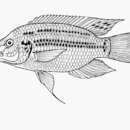Diagnostic Description
provided by Fishbase
Diagnosis: A small bodied tilapia (Ref. 118638). About 50% of individuals have IV anal spines, the modal numbers of vertebrae (29), dorsal rays (27) and gill-rakers (15) are low, and the jaws of breeding males are enlarged (Ref. 2). Females, subadult males and juveniles with a silver/grey flank colour, light ventral colour, and characteristic melanin pattern of 7-9 broken vertical stripes on the dorsal side giving a spotted appearance; males darker, with a series of white spots/bars on the flanks; ripe males have red margins on dorsal and caudal, with a reddish tinge to the pectoral fins; males from southern populations showed a bluish sheen and less contrasting male colouration (Ref. 118638). In breeding males the throat and chest are black and broad dark vertical bars are conspicuous on the lower half of the body (Ref. 2, 4967, 54096).Description: Lips rather thick; maxillary extending nearly to below eye in some males (Ref. 2). Tooth band wide (Ref. 4967, 55060); teeth in 3-5 series; outer bicuspid, or with minor cusp reduced or absent in breeding or recently spent males, 46-66 in outer row of upper jaw; inner tricuspid (Ref. 2). Gill-rakers on lower part of anterior arch 14-16, rarely 17 (Ref. 2). Lower pharyngeal bone with blade as long as or a little longer than toothed area, which has concave sides and fine teeth (Ref. 2). Vertebrae 29-30 (Ref. 2). Scales on cheek usually in 2 rows, occasionally 3, in lateral series 29-31, between origin of dorsal and lateral line 3.5-4, between bases of pectoral and pelvic fins 4-6; small on chest (Ref. 2). Dorsal fin with XVI-XVIII spines and 9-10 soft rays; anal fin with III-IV spines and 9-11 soft rays; caudal fin truncate; pectoral fins short, not reaching anus; pelvic drawn out into a long filament in mature males (Ref. 2, 55060).Colouration: In alcohol, females and sexually inactive males have the basic melanin pattern very strongly marked, the horizontal and vertical bands usually represented by intense black blotches, which may be contiguous; a blotch on the top of the caudal peduncle is usually well-marked; the caudal fin may be immaculate or may have part of its area crossed by vertical bars or series of spots (Ref. 2). With indications of about 7 vertical black bars across lower horizontal band (Ref. 55060). Line of 4-5 black spots above dorsal lateral line and black spot on dorsal side of caudal peduncle; tilapia-mark an oval black spot near hind end of dorsal fin (Ref. 55060). In some males, the vertical bars are stronger on the lower half of the flanks and the spaces between them on the abdomen, as well as an uneven and variable area on the operculum, may be whitish silver or aluminium-coloured; the branchiostegal membrane is black in males, pale in females; the genital papilla is white in both sexes and in males is conspicuous against the dark background (Ref. 2). In life, breeding males did not have a marked breeding dress and the corner of the caudal fin is white (Ref. 2).
- Recorder
- Crispina B. Binohlan
Life Cycle
provided by Fishbase
A maternal mouthbrooder (Ref. 118638).
Morphology
provided by Fishbase
Dorsal spines (total): 16 - 18; Dorsal soft rays (total): 9 - 11; Anal spines: 3 - 4; Analsoft rays: 9 - 11; Vertebrae: 29 - 30
- Recorder
- Crispina B. Binohlan
Trophic Strategy
provided by Fishbase
Inhabits rivers (Ref. 4967).
- Recorder
- Grace Tolentino Pablico
Biology
provided by Fishbase
A maternal mouthbrooder (Ref. 118638). There is evidence of hybridization with native Oreochromis jipe in northern Tanzania, and non-native O. niloticus in southern Tanzania (Ref. 118638). Of only minor importance to artisanal fisheries (Ref. 118638). Maximum standard length of 18 cm (Ref. 4967) is not confirmed (Ref. 2, G.F. Turner pers. comm.); maximum total length reported as 20.8 cm (Ref. 2, 118638).
Importance
provided by Fishbase
fisheries: ; aquaculture: likely future use
Oreochromis korogwe: Brief Summary
provided by wikipedia EN
Oreochromis korogwe (Korogwe tilapia) is a species of cichlid native to Kenya and Tanzania, where it occurs in the Pangani River system, as well as the Zigi River. This species can reach a standard length of 20.8 cm (8.2 in).
- license
- cc-by-sa-3.0
- copyright
- Wikipedia authors and editors

